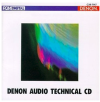Very well written and interesting review, NTTY!
Those curious about having a glimpse of the performance of this Denon DCD-SA1 in SA-CD mode can download for an affordable price a test made with an Audio Precision System Two and a 0 dB SA-CD signal engraved on the Philips Super Audio CD DAC Test Disc : https://www.testberichte.de/preisvergleich/level4_stereoplay_27256.html
Beware FFT length and number of measurements taken to be averaged by the Audio Precision software are not disclosed in the aforementioned review. But the published noise floor looks almost exactly like what you see on the 32,768 points 8 average FFT in DSD mode displayed in the Burr Brown DSD1792 datasheet.
Incidentally, this DSD1792A (or the nearly identical PCM1792A) seems to me still the best D/A converter of the Burr Brown range of converter chips despite its age (20 years). The newer PCM1795 did get a fancier 32 bits input interface instead of the 24 bits input of the earlier DAC, but this change was apparently made to the detriment of both the digital filter in PCM mode and the overall performance specifications.
Don't forget Philips, which co-developed SA-CD and DSD with Sony in the same way the two corporations have co-developed the CD!
I once read messages from the great engineer Carel Dijkmans (Philips) on LinkedIn and other messages on forums from a former insider at Philips then Sony that lead me to believe that the technical rational behind recording and distributing music in a sigma-delta format were to completely avoid the issue of aliasing or at least make it practically irrelevant thanks to a sampling frequency put in the MHz region, far far above any high frequencies that can be even remotely considered audio. That and also capture better the shape of unpredictable and non-steady-state analogue signals. A bit for the same reason that it is generally recommended to get a digital oscilloscope whose sampling frequency is not 2, but 5 to 10 times the highest frequency of interest if signal types other than pure sinus are to be observed.
Those curious about having a glimpse of the performance of this Denon DCD-SA1 in SA-CD mode can download for an affordable price a test made with an Audio Precision System Two and a 0 dB SA-CD signal engraved on the Philips Super Audio CD DAC Test Disc : https://www.testberichte.de/preisvergleich/level4_stereoplay_27256.html
Beware FFT length and number of measurements taken to be averaged by the Audio Precision software are not disclosed in the aforementioned review. But the published noise floor looks almost exactly like what you see on the 32,768 points 8 average FFT in DSD mode displayed in the Burr Brown DSD1792 datasheet.
Incidentally, this DSD1792A (or the nearly identical PCM1792A) seems to me still the best D/A converter of the Burr Brown range of converter chips despite its age (20 years). The newer PCM1795 did get a fancier 32 bits input interface instead of the 24 bits input of the earlier DAC, but this change was apparently made to the detriment of both the digital filter in PCM mode and the overall performance specifications.
How to conclude?
- SACD measurements left me wondering what was into this move from Sony. I did not see anything tangibly good for me, especially knowing that I used a referenced SACD Test disc for the measurements, which I suppose has been created with great care(?).
- Noise shaping techniques have improved, allowing the theoretical 16bits of CD Audio to be actually much lower. What's left to SACD when compared to CDA is that extended bandwidth which I did not find here, at least from the Denon Audio Check SACD.
Don't forget Philips, which co-developed SA-CD and DSD with Sony in the same way the two corporations have co-developed the CD!
I once read messages from the great engineer Carel Dijkmans (Philips) on LinkedIn and other messages on forums from a former insider at Philips then Sony that lead me to believe that the technical rational behind recording and distributing music in a sigma-delta format were to completely avoid the issue of aliasing or at least make it practically irrelevant thanks to a sampling frequency put in the MHz region, far far above any high frequencies that can be even remotely considered audio. That and also capture better the shape of unpredictable and non-steady-state analogue signals. A bit for the same reason that it is generally recommended to get a digital oscilloscope whose sampling frequency is not 2, but 5 to 10 times the highest frequency of interest if signal types other than pure sinus are to be observed.
Last edited:

